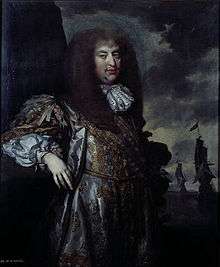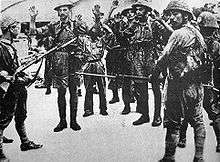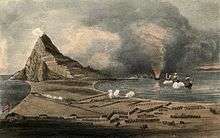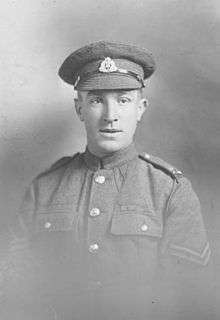Suffolk Regiment
| Suffolk Regiment | |
|---|---|
 Badge of the Suffolk Regiment | |
| Active | 1685–1959 |
| Country |
|
| Branch |
|
| Type | Infantry |
| Role | Line infantry |
| Size |
1–2 Regular battalions |
| Garrison/HQ | Gibraltar Barracks, Bury St Edmunds |
| Nickname(s) | "Old Dozen" |
| Engagements |
Battle of Minden Eureka Rebellion Battle of Singapore |
The Suffolk Regiment was an infantry regiment of the line in the British Army with a history dating back to 1685. It saw service for three centuries, participating in many wars and conflicts, including the First and Second World Wars, before being amalgamated with the Royal Norfolk Regiment to form the 1st East Anglian Regiment (Royal Norfolk and Suffolk) in 1959 which, in 1964, was further amalgamated with the 2nd East Anglian Regiment (Duchess of Gloucester's Own Royal Lincolnshire and Northamptonshire), the 3rd East Anglian Regiment (16th/44th Foot) and the Royal Leicestershire Regiment to create the present Royal Anglian Regiment.
Early history




The regiment was raised by Henry Howard, 7th Duke of Norfolk as the Duke of Norfolk's Regiment of Foot in 1685 and incorporated men from the East Anglian counties of Norfolk and Suffolk. It was subsequently named after ten different colonels and was ranked in 1747 as the 12th Foot regiment.[1]
It was originally formed to combat the Monmouth Rebellion, but was not disbanded when the rebellion was defeated. Following the 1688 Glorious Revolution its Colonel Lord Lichfield was dismissed for his sympathies with James II and was replaced by Henry Wharton.[2] Under Wharton the regiment participated in Marshal Schomberg's expedition to Ireland in 1689. It captured the unoccupied town of Belfast and then took part in the Siege of Carrickfergus.[3]
Wharton died of fever in October 1689 while the regiment was part of the Dundalk Camp. Richard Brewer took command of the regiment and led it during the Nine Years' War in Flanders.[4] The regiment was placed on the Irish establishment following the Treaty of Ryswick in 1697, and was not disbanded. It was subsequently stationed in Jamaica during the War of the Spanish Succession.[5]
In 1751, the regiment was renamed the 12th Regiment of Foot. In 1758 the 2nd Battalion of the regiment was separated from it and formed the basis of the 65th (2nd Yorkshire, North Riding) Regiment of Foot.[6] In 1782, it was given a county association as the 12th (East Suffolk) Regiment of Foot.[1]
While garrisoning the Australian Colony of Victoria in 1854, detachments from the regiment, the 40th Regiment of Foot and colonial police, suppressed the Eureka Rebellion, by gold prospectors at Ballarat.[7]
1895 to 1914
The 1st Battalion served in the Second Boer War: it assaulted a hill near Colesberg in January 1900 and suffered many casualties including the commanding officer.[7]
By contrast between 1895 and 1914, the 2nd Battalion, Suffolk Regiment was not involved in hostilities. It was stationed for the majority of the time in India. Garrison postings during this period include; Secunderabad (India) 1895, Rangoon and the Andaman Islands (Burma) 1896 to 1899, Quetta (North West Frontier) 1899 to 1902, Karachi and Hyderabad (Northern India, now Pakistan) 1902 to 1905, Madras (India) 1905 to 1907, Aden 1907, returning to England in 1908.[7]
During its service in India the 2nd Battalion became known as a "well officered battalion that compared favourably with the best battalion in the service having the nicest possible feeling amongst all ranks". The 2nd was also regarded as a good shooting battalion with high level of musketry skills.[8]
The spirit of independence and self-reliance exhibited by officers and non-commissioned officers led to the 2nd Battalion taking first place in the Quetta Division of the British Army of India, from a military effectiveness point of view, in a six-day test. This test saw the men under arms for over 12 hours a day conducting a wide selection of military manoeuvres, including bridge building, retreats under fire, forced marches and defending ground and fixed fortifications.[9]
First World War
Regular Army
The 1st Battalion landed at Le Havre as part of the 84th Brigade in the 28th Division in January 1915 for service on the Western Front and then transferred to Egypt in 24 October 1915.[10] It suffered some 400 casualties at the Second Battle of Ypres in May 1915.[7]
The 2nd Battalion landed at landed at Le Havre as part of the 14th Brigade in the 5th Division in August 1914.[10] The value of the 2nd Battalion's 20 years of peacetime training was exemplified at the Battle of Le Cateau on 26 August 1914, a mere 23 days since Britain had declared war on Germany. In this action the 2nd Battalion undertook a fierce rear-guard defence out-manned and out-gunned by superior numbers of enemy. The 2nd Battalion held their defensive position despite losing their commanding officer, Lt. Col. C.A.H. Brett DSO, at the commencement of the action and their second in command, Maj. E.C. Doughty, who was severely wounded after six hours of battle as he went forward to take ammunition to the hard-pressed battalion machine gunners.[11]
Almost totally decimated as a fighting unit after over eight hours of incessant fighting, the 2nd Battalion, Suffolk Regiment was gradually outflanked but would still not surrender. This was despite the fact that the German Army, knowing the 2nd Battalion had no hope of survival, entreated them to surrender, even ordering the German buglers to sound the British Cease Fire and gesticulating for the men of the 2nd to lay down their arms. At length an overwhelming force rushed the 2nd Battalion from the rear, bringing down all resistance and the 2nd's defence of Le Cateau was at an end. Those remaining alive were taken captive by the Germans, spending the next four years as prisoners of war and not returning home until Christmas Day 1918.[12]
As an example of their valour and the level of training they had been subject to as a peacetime unit, it is noted that 720 men of 2nd Battalion, Suffolk Regiment total roll call of some 1,000, many of whom had been with the battalion since the 1899 posting to Quetta, were killed, wounded or captured. This fight-to-the-last-man defence at Le Cateau was later recognised as a key factor in preventing the German occupation of Paris. The battalion, due to the casualties sustained, was transferred to GHQ Troops before, on 25 October, transferring to the 8th Brigade of the 3rd Division and, almost a year later, transferred to 76th Brigade of the same division, where they were to remain for the rest of the year.[13]
Territorial Force
The 1/4th Battalion landed at Le Havre as part of the Jullundur Brigade of the 3rd (Lahore) Division in November 1914 for service on the Western Front.[10] The 1/5th Battalion landed at Suvla Bay as part of the 163rd (1/1st Norfolk and Suffolk) Brigade in the 54th (East Anglian) Division in August 1915; it was evacuated from Gallipoli in December 1915 and moved to Egypt and saw action again at First Battle of Gaza in March 1917.[10]
Hostilities-only battalions

The 7th (Service) Battalion landed at Boulogne-sur-Mer as part of the 35th Brigade in the 12th (Eastern) Division in May 1915 for action on the Western Front.[10] The 8th (Service) Battalion landed in France as part of the 53rd Brigade in the 18th (Eastern) Division in July 1915 also for action on the Western Front.[10] The 9th (Service) Battalion landed at Boulogne-sur-Mer as part of 71st Brigade in the 24th Division in August 1915 also for action on the Western Front:[10] Sergeant Arthur Frederick Saunders of the 9th Battalion, was awarded the Victoria Cross while serving with the battalion during the Battle of Loos, the largest British Army offensive of 1915.[14] The 11th (Service) Battalion (Cambridgeshire) landed at Boulogne-sur-Mer as part of the 101st Brigade in the 34th Division in January 1916 also for action on the Western Front.[10] The 12th (Service) Battalion (East Anglian) landed at Le Havre as part of the 121st Brigade in the 40th Division in June 1916 also for action on the Western Front.[10]
Inter-war period
The 1st battalion saw action in the campaign against the Moplahs in Malabar in 1922 while the 2nd battalion was deployed to Shanghai in 1927 before moving to India in 1929.[7]
Second World War
Regular Army

The 1st Battalion, Suffolk Regiment was a Regular Army unit stationed in Devonport as part of the 8th Infantry Brigade, 3rd Infantry Division and served with the British Expeditionary Force (BEF) in France from late 1939 to May 1940. The division was commanded by Major-General Bernard Montgomery. With the rest of the BEF, it was evacuated from Dunkirk in 1940. The next four years were spent training in the United Kingdom for the invasion of Normandy in 1944, otherwise known as D-Day. The 1st Battalion, under the command of Lieutenant Colonel Richard E. Goodwin, was involved in attacking and taking the Hillman Fortress on D-Day itself. They served with the 3rd Infantry Division throughout the entire North West Europe Campaign from D-Day to Victory in Europe Day in 1945. By the end of the war the 1st Battalion had lost 215 men killed in action.[15]
The 2nd Battalion of the Suffolk Regiment was serving in India at the outbreak of the Second World War, spending the early years of the war mainly deployed on internal security duties. In 1943 the battalion transferred to the 123rd Indian Infantry Brigade, part of the 5th Indian Infantry Division and served with them in the Burma Campaign. In 1944 the battalion was flown to Imphal to clear Japanese positions.[7]
Territorial Army

The 4th/5th Battalion, Suffolk Regiment was a Territorial Army unit and was split to help re-create the 5th Battalion, which had been disbanded in the 1920s, in 1939 due to the Territorial Army being doubled as another conflict had, by this time, seemed inevitable. Both battalions were assigned to the 54th Infantry Brigade, which included the 4th Royal Norfolk Regiment, assigned to the 18th Infantry Division, a 2nd Line duplicate of the 54th (East Anglian) Infantry Division. Despite being a 2nd Line formation, the 18th Division contained many 1st Line units. The division spent the early years of the war in the defence of England and guarding against a possible German invasion after the bulk of the British Army was evacuated at Dunkirk. In late 1941 the 18th Division, the 4th and 5th Suffolks included, were originally to be sent to Egypt but instead were sent to Singapore to help strengthen the garrison there after Japan entered the war in December 1941. In early 1942, both the 4th and 5th battalions fought briefly in the defence of Singapore against the Japanese, with the 18th Division, before British Commonwealth forces on that island surrendered on 15 February 1942 under the orders of Lieutenant-General Arthur Percival. Men from the two battalions suffered great hardship as POWs and were forced to participate in the construction of the Burma Railway.[7]
Hostilities-only

The 7th Battalion, Suffolk Regiment was a war-formed unit raised in June 1940, shortly after Dunkirk, and, on 10 October, was assigned to the 210th Independent Infantry Brigade (Home) alongside other hostilities-only battalions. With the brigade, the battalion alternated between home defence duties and training to repel an expected invasion of the United Kingdom. In November 1941, with the threat of invasion reduced due to the oncoming winter, the battalion was converted to a regiment in the Royal Armoured Corps, becoming 142nd Regiment Royal Armoured Corps (142 RAC) and joined 25th Army Tank Brigade. They continued to wear their Suffolk Regiment cap badge on the black beret of the Royal Armoured Corps as did all infantry units converted this way.[16] Equipped with Churchill tanks the regiment landed at Algiers in 1943, fighting at the Battle of Medjez-el Bab in the Tunisia Campaign in April 1943. After the end of the fighting in North Africa the regiment remained there until April 1944 when, with the rest of the brigade, it landed at Naples, Italy, destined for service in the Italian campaign, where they fought in Operation Diadem, where the Allies finally broke out of the Gustav Line. 142 RAC was present when the Allies overcame the Hitler Line and the Gothic Line in late 1944. However, due to a shortage of manpower, the regiment was disbanded in January 1945 while in northern Italy.[17]
The 50th (Holding) Battalion was created in late May 1940, around the time of the Dunkirk evacuation, and was originally intended temporarily to 'hold' men who were medically unfit, awaiting orders, or, as this was at the time of Dunkirk, returning from overseas service. However, in October, the battalion was re-designated as the 8th Battalion. In addition, the 6th, 9th, 30th, 31st and 70th (Young Soldiers) Battalions were also formed, although none of these saw service overseas.[17]
Post war
The regiment was amalgamated with the Royal Norfolk Regiment to form the 1st East Anglian Regiment (Royal Norfolk and Suffolk) in 1959.[18]
Battle honours


The regiment's battle honours were as follows:[1]
- Early Wars
- The Great War
- Mons, Le Cateau, Retreat from Mons, Marne 1914, Aisne 1914, La Bassée 1914, Givenchy 1914, Neuve Chapelle, Ypres 1915 '17 '18, Gravenstafel, St Julien, Frezenberg, Bellewaarde, Aubers, Hooge 1915, Loos, Somme 1916 '18, Albert 1916 '18, Bazentin, Delville Wood, Pozières, Flers-Courcelette, Morval, Thiepval, Le Transloy, Ancre Heights, Ancre 1916 '18, Arras 1917 '18, Scarpe 1917 '18, Arleux, Pilckem, Langemarck 1917, Menin Road, Polygon Wood, Poelcappelle, Passchendaele, Cambrai 1917 '18, St. Quentin, Bapaume 1918, Lys, Estaires, Messines 1918, Hazebrouck, Bailleul, Kemmel, Béthune, Scherpenberg, Amiens, Hindenburg Line, Épéhy, Canal du Nord, Courtrai, Selle, Valenciennes, Sambre, France and Flanders 1914–18, Struma, Doiran 1918, Macedonia 1915–18, Suvla, Landing at Suvla, Scimitar Hill, Gallipoli 1915, Egypt 1915-17, Gaza, El Mughar, Nebi Samwil, Jerusalem, Tell 'Asur, Battle of Megiddo 1918, Sharon, Palestine 1917-18
- The Second World War
- Dunkirk 1940, Normandy Landing, Odon, Falaise, Venraij, Brinkum, North-West Europe 1940 '44-45, Singapore Island, Malaya 1942, North Arakan, Imphal, Burma 1943–45.
Victoria Cross
Victoria Crosses were awarded to the following men of the regiment:
- Corporal Sidney James Day, First World War (26 August 1917)
- Sergeant Arthur Frederick Saunders, First World War (26 September 1915)
Colonels-in-Chief
- 1944: The Princess Anne
Colonels of the Regiment
Colonels of the regiment were as follows:[1]
- 1685–1686: Col Henry Howard, 7th Duke of Norfolk
- 1686–1688: Col Edward Lee, 1st Earl of Lichfield
- 1688: Col Robert Carey, 6th Baron Hunsdon
- 1688–1689: Col Hon. Henry Wharton
- 1689–1702: Col Richard Brewer
- 1702–1712: Maj-Gen John Livesay
- 1712–1717: Lt-Gen Richard Philipps
- 1717–1725: Brig-Gen Thomas Stanwix
- 1725–1741: Gen Thomas Whetham
- 1741–1745: Col Scipio Duroure
- 1745–1757: Lt-Gen Henry Skelton
12th Regiment of Foot
- 1757–1766: Lt-Gen Robert Napier
- 1766–1779: Gen Henry Clinton
- 1779–1811: Gen William Picton
12th (East Suffolk) Regiment
- 1811–1823: Gen Sir Charles Hastings, 1st Baronet
- 1823–1852: Gen Hon. Robert Meade
- 1852–1857: Lt-Gen Sir Richard Goddard Hare Clarges KCB
- 1857–1864: Lt-Gen Charles Anthony Ferdinand Bentinck
- 1864–1875: Gen Henry Colvile
- 1875–1888: Gen John Patton [19]
The Suffolk Regiment
- 1888–1900: Gen John Maxwell Perceval CB [20]
- 1900–1904: Gen Hon Sir Percy Robert Basil Feilding KCB
- 1904–1918: Lt-Gen Hon. Bernard Matthew Ward CB
- 1918: Lt-Gen Sir Alfred Edward Codrington GCVO KCB
- 1918–1919: Lt-Gen Sir Thomas D'Oyly Snow KCB KCMG
- 1919–1925: Gen Sir Thomas Lethbridge Napier Morland KCB KCMG DSO
- 1925–1939: Maj-Gen Sir John Ponsonby KCB CMG DSO
- 1939–1947: Col Walter Norris Nicholson CMG DSO
- 1947–1957: Brig Edward Henry Walford Backhouse CBE
- 1957–1959: Brig Richard Hobson Maxwell CB
Suffolk Regiment Museum
The Suffolk Regiment Museum is at The Keep, Gibraltar Barracks, Newmarket Road, Bury St Edmunds, Suffolk. Exhibits include uniforms, weapons, medals, badges, insignia, photographs, regimental regalia and memorabilia. Admission is free.
Notes
- 1 2 3 4 "Suffolk Regiment". Regiments.org. Archived from the original on January 3, 2006. Retrieved 21 February 2016.
- ↑ Cannon, p. 5
- ↑ Cannon, p. 6
- ↑ Cannon, p. 13
- ↑ Cannon, p. 18
- ↑ The 63rd Regiment of Foot (another regiment recruiting in Suffolk) became the 63rd (West Suffolk) Regiment of Foot, which would later form the 1st Battalion, Manchester Regiment.
- 1 2 3 4 5 6 7 Lummis, Eric. "The History of the Suffolk Regiment". Suffolk Regiment. Retrieved 21 February 2016.
- ↑ Webb 1914 in Bell 2007
- ↑ Bell 2007 & Webb 1914
- 1 2 3 4 5 6 7 8 9 "Suffolk Regiment". The Long, Long Trail. Retrieved 21 February 2016.
- ↑ Bird, Antony (2008). Gentlemen, We Will Stand and Fight. Crowood. ISBN 978-1847970626.
- ↑ Murphy 1928 & Bell 2007
- ↑ "The 3rd Division in 1914-1918". The Long, Long Trail. Retrieved 24 January 2016.
- ↑ The London Gazette: (Supplement) no. 29527. pp. 3409–3410. 28 March 1916. Retrieved 19 May 2015.
- ↑ Delaforce, p. 211.
- ↑ George Forty (1998), "British Army Handbook 1939–1945", Stoud: Sutton Publishing, pp. 50–1.
- 1 2 "The Suffolk Regiment Day by Day". Retrieved 21 February 2016.
- ↑ "Birth of a regiment". East Anglian Film Archive. 19 September 1959. Retrieved 24 January 2016.
- ↑ The London Gazette: no. 25804. p. 1989. 3 April 1888. Retrieved 2016-07-08.
- ↑ The London Gazette: no. 25804. p. 1989. 3 April 1888. Retrieved 2016-07-08.
References
- Bell, K.M (2007). A Private from the Suffolk Regiment (an unpublished manuscript). Suffolk Records Office Reference GB554/Y/515.
- Cannon, Richard (1848). Historical record of the 12th or the East Suffolk Regiment of Foot. Parker, Furnivall & Parker.
- Delaforce, Patrick (1995). Monty's Iron Sides. Stroud: Alan Sutton. ISBN 0-7509-0781-9.
- Mills, T.F. "The Suffolk Regiment". regiments.org. Archived from the original on January 4, 2007. Retrieved February 7, 2007.
- Murphy, Lt. Col.C.C.R. The History of the Suffolk Regiment 1914 to 1927.
- Scarfe, Norman (2006). Assault Division: A History of the 3rd Division from the Invasion of Normandy to the Surrender of Germany. Stroud, Gloucestershire, Spellmount. ISBN 1-86227-338-3.
- Webb, Lt. Col. E.A.H. (1914). History of the 12th (The Suffolk) Regiment 1685 to 1913.
External links
| Wikimedia Commons has media related to Suffolk Regiment. |
- Friends of the Suffolk Regiment
- Friends of the Suffolk Regiment - Museum Information
- Regimental history from the St. Edmundsbury Borough Council
| Preceded by 12th Regiment of Foot |
The Suffolk Regiment 1782–1959 |
Succeeded by 1st East Anglian Regiment |
